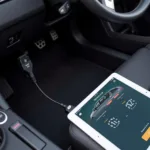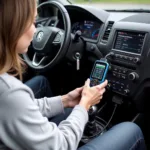The 1998 Ford Mustang V6 was equipped with an OBD2 system, marking a significant step in automotive diagnostics. This means you can use an OBD2 scanner to access valuable information about your car’s engine, emissions, and other systems. But understanding what your 1998 Mustang V6 OBD2 port tells you can feel like deciphering a secret code. This comprehensive guide will demystify your OBD2 system and equip you with the knowledge to diagnose issues, optimize performance, and keep your Mustang running smoothly.
What is OBD2 and Why Should You Care?
OBD2, short for On-Board Diagnostics, is a standardized system that allows external devices, like OBD2 scanners, to communicate with your car’s computer. Introduced in 1996, OBD2 became mandatory for all vehicles sold in the United States, including your 1998 Mustang V6.
Think of your OBD2 system as your car’s own personal translator. It continuously monitors various systems, detecting malfunctions and storing diagnostic trouble codes (DTCs) when issues arise. These codes act like clues, pointing you toward the root of the problem.
By connecting an OBD2 scanner to your Mustang’s port, you gain access to these DTCs, along with real-time data on engine performance, sensor readings, emissions status, and more. This empowers you to:
- Diagnose engine problems: Identify the source of check engine lights, misfires, rough idling, or decreased fuel efficiency.
- Monitor emissions readiness: Ensure your Mustang complies with environmental regulations.
- Track performance parameters: View live data on speed, RPM, coolant temperature, and other metrics.
- Reset warning lights: Clear DTCs and turn off the check engine light after resolving an issue.
Common 1998 Mustang V6 OBD2 Codes and Their Meanings
While an OBD2 scanner unlocks a wealth of information, interpreting the codes can be daunting. Here are some common DTCs you might encounter on your 1998 Mustang V6 and their potential interpretations:
- P0171 and P0174: These codes indicate a lean fuel mixture, meaning there’s too much air or not enough fuel entering the engine. Common culprits include vacuum leaks, faulty oxygen sensors, or a malfunctioning fuel pump.
- P0300 – P0306: These codes represent misfires in specific cylinders. Causes range from faulty spark plugs or wires to injector problems or a failing ignition coil pack.
- P0401: This code signals insufficient exhaust gas recirculation (EGR) flow. A clogged EGR valve, a faulty EGR valve position sensor, or issues with the EGR solenoid are common reasons for this code.
- P0125: This code suggests a problem with the coolant temperature sensor or its circuit. A faulty sensor can lead to inaccurate readings, affecting fuel economy and engine performance.
Choosing the Right OBD2 Scanner for Your 1998 Mustang V6
With a plethora of OBD2 scanners available, selecting the right one for your 1998 Mustang V6 depends on your needs and budget.
- Basic Code Readers: These affordable scanners can read and clear basic DTCs, offering a starting point for diagnosing check engine lights.
- Advanced Scan Tools: Ideal for DIY enthusiasts and mechanics, these scanners provide access to live data, sensor readings, and more in-depth diagnostic capabilities.
- Bluetooth Scanners: These scanners connect wirelessly to your smartphone or tablet, allowing you to view data and utilize diagnostic apps for added functionality.
Beyond the Codes: Maximizing Your OBD2 Experience
While reading and understanding DTCs is crucial, your OBD2 system offers more than just error codes. By delving deeper, you can:
- Monitor Fuel Economy: Track your Mustang’s fuel consumption patterns, identify areas for improvement, and potentially save money on gas.
- Analyze Sensor Data: Monitor oxygen sensor readings, throttle position, and other vital parameters to diagnose problems early on.
- Conduct Performance Tests: Measure acceleration times, braking distances, and other performance metrics to gauge your Mustang’s capabilities.
Conclusion: Empowering Ownership through OBD2
Your 1998 Mustang V6’s OBD2 system is a powerful tool, providing a gateway to understanding your car’s inner workings. By harnessing its capabilities, you can diagnose issues accurately, optimize performance, and make informed decisions about your Mustang’s maintenance. Whether you’re a seasoned mechanic or a DIY enthusiast, investing in an OBD2 scanner and learning its language empowers you to take control of your driving experience.
FAQ
1. Where is the OBD2 port located on my 1998 Mustang V6?
The OBD2 port is typically located under the dashboard on the driver’s side.
2. Can I clear OBD2 codes myself?
Yes, most OBD2 scanners allow you to clear DTCs. However, it’s crucial to address the underlying problem before clearing codes.
3. What does a flashing check engine light mean?
A flashing check engine light typically indicates a more serious problem requiring immediate attention.
4. Do I need a special OBD2 scanner for my 1998 Mustang V6?
Most standard OBD2 scanners will work with your 1998 Mustang V6.
5. Can an OBD2 scanner tell me everything that’s wrong with my car?
While OBD2 scanners provide valuable insights, they may not detect every issue. Complex problems might require professional diagnosis.
Need more help with your 1998 Mustang V6 OBD2 system?
Check out our other articles on:
- Understanding Specific OBD2 Codes
- Choosing the Right OBD2 Scanner for Your Needs
- Advanced OBD2 Diagnostic Techniques
Get in touch with our team of experts for personalized assistance:
WhatsApp: +1(641)206-8880, Email: [email protected]. We’re here to help 24/7.

